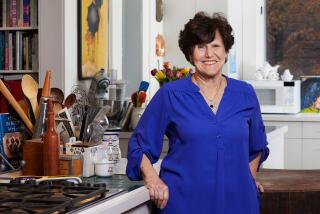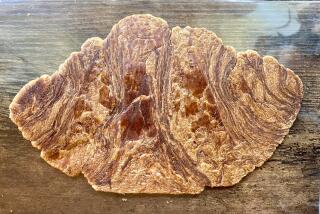Beyond coffee shop Danish
!["I use margarine because it makes [the dough] more elastic," baker Henrik Gram says.](https://ca-times.brightspotcdn.com/dims4/default/5be6065/2147483647/strip/true/crop/600x408+0+0/resize/1200x816!/quality/75/?url=https%3A%2F%2Fcalifornia-times-brightspot.s3.amazonaws.com%2Fc7%2F80%2Fe24ca3f9846288c82a26a8f77223%2Fla-fo-bakery-l0rydtnc)
“Coffee and Danish”: You can’t help but think of a stale pot of truck stop brew sitting next to gunky jelly-laden pastry. But that couldn’t be further from the original. Sure Denmark is a country that runs on coffee, but rather than the dense lump of dough that we know, their daily cups are accompanied by delicate, flaky, marzipan-filled morsels that we rarely see in America.
“Coffee is an integral part of the daily lives of Scandinavians,” says Beatrice Ojakangas, author of “The Great Scandinavian Baking Book.” “It is served at three of the six meals eaten per day, and of course, cookies and pastries come along with that ritual.”
But until recently, Southern Californians who wanted even a hint of those sweets had to drive to kitschy Solvang. However, since Rasmus Lee opened Hygge Bakery downtown, Danish immigrants and locals are flocking to the storefront at 11th and Hope for the traditional Danish pastries crafted by baker Henrik Gram.
The bakery is centered on the concept of hygge — pronounced “hyoogeh” — which is Denmark’s equivalent of the Italian la dolce vita. There’s no direct translation to English, but it’s best described as a sort of cozy tranquility that usually involves good food and good company.
Hygge Bakery sells kringle and spandauer, both quintessential Danish pastries, along with countless other traditional sweets such as Napoleon hat cookies, butter cookies, cinnamon rolls and various cakes.
Kringle is made of puff pastry dough that’s layered with marzipan and remonce, a mixture of creamed butter and sugar. Then it’s sprinkled with almond slices and coarse sugar. It comes in either small bar-shaped servings or prepared as a pretzel-shaped cake, which resembles the old guild sign of Danish bakers.
Spandauer is what the Danishes we usually see are imitating — round pastries made with laminated, or layered, dough and a center of either marzipan or custard.
Kringle and spandauer are what the Danish refer to as weinerbrod, or Viennese bread. The story behind the origins differs depending on whom you’re talking to. Some believe that Danish bakers brought back the recipes from Vienna. Others say it was young traveling Viennese bakers who took the recipes to Denmark. Either way, it’s generally agreed that these delicate, buttery pastries appeared around the 19th century and have since become a part of the daily ritual of hygge.
Lee says traditional Danishes never use cream cheese. Danishes are sometimes made with fruit, usually apple or raspberry, but the addition of jelly and cream cheese is a purely American adaptation.
Marzipan can be found in most Danish pastries, and Gram is particularly adept with it. (Perhaps that’s what got him one of his previous gigs baking for the queen of Denmark.)
Gram also insists on using margarine for his baking, and even though he can’t get the exact brand he used back in Denmark, he’s found a Swedish supplier that has a suitable substitute.
“I use margarine because it makes [the dough] more elastic,” Gram says. “Butter is too stiff, and it doesn’t work as well with maintaining the layers once they are folded over.”
Considering how many layers there are in his pastries, this is a crucial part of the process. Spandauer is composed of 27 flaky layers topped with a marzipan custard center. It’s the quintessential Danish pastry that can be found in every glass case across Denmark, and it’s also what the cheap truck-stop Danishes are modeled after. But Gram’s featherweight, flaky dough is so far from what we know, it’s shocking.
Perhaps Gram’s deft hand with dough comes with practice. He comes from a family of bakers and has been working in bakeries in and around Copenhagen since 1971. But his career took a turn to the U.S. when he saw an ad in the local Danish bakers’ trade publication.
Lee had placed that ad in hopes of making his bakery in Los Angeles as authentic as possible. “I always find that Europeans talk about how much it’s better over there,” he says. “Instead of complaining about it, I’d rather bring the experience here instead of saying you have to wait to go back home to get it. We wanted it 100% authentic.
“There are French bakeries everywhere. But Danish bakeries are harder to find.”
There’s no shortage of bakeries in Denmark, where “on every corner there’s either a bakery or a bank,” Lee says. Of course, each baker’s style differs, but there are a few pastries you’ll find nearly everywhere cross the country. The spandauer and kringle are omnipresent, and so are Danish wreath cookies, which Americans may recognize from the blue tins given as office gifts around Christmas. They taste similar to an airy shortbread, dainty and so delicious you always want just one more.
Another quintessential Danish pastry is water kringle, which looks similar to a cinnamon roll or bun. The water version of kringle is made with a bready dough rather than puff pastry and is quite a bit easier for a home baker to attempt.
It’s also versatile; if you forgo the addition of remonce, the dough can be used to make various tea buns of sweet and savory varieties. Hygge has a few varieties to sample in the bakery, including one made with plump little raisins.
They also carry another staple of the Nordic diet: freshly baked bread. Each day, dense rye loaves — known in Denmark as rugbrod — come out of Hygge’s oven, heavy like a hot brick. Inside its hearty, seedy crust is a moist, delicate center that begs for a smear of Danish blue cheese. Lee has been hosting Sunday bread tastings every couple of months to get the locals interested and inspire them to adopt the concept of getting their daily bread.
“It’d be great if it was that way here,” Lee says. “I absolutely love America, but one thing I’ve never understood is why people accept bad bread. I just hope what we’re doing here can change that.”
Hygge Bakery: 1106 S. Hope St., Los Angeles, CA 90015. 213-995-5022. https://hyggebakery.com/
More to Read
Eat your way across L.A.
Get our weekly Tasting Notes newsletter for reviews, news and more.
You may occasionally receive promotional content from the Los Angeles Times.






